Вестник Воронежского государственного университета инженерных технологий @vestnik-vsuet
Статьи журнала - Вестник Воронежского государственного университета инженерных технологий
Все статьи: 2713
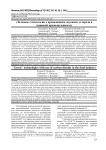
"Зеленые" технологии с применением двуокиси углерода в пищевой промышленности
Статья научная
Опыт развития социальных государств свидетельствует о наличии прямой зависимости между экономическим, социальным и экологическим развитием и инновационной направленностью проводимой промышленной политики. Иными словами, главной целью промышленной политики должно стать обеспечение высокого уровня качества жизни, социальных гарантий и экологической безопасности, достигаемое путем инновационного развития определенного комплекса отраслей. Одной из таких отраслей является пищевая промышленность. Ее главная цель на современном этапе – обеспечение эколого-социального типа экономического роста. Инновации в пищевой промышленности, приносящие экономический, экологический и социальный эффекты должны стать приоритетными при формировании инновационно-промышленной политики. Таких инноваций в пищевой промышленности России разработано достаточно много, однако инструментов для стимулирования их внедрения явно не хватает. Рассматривая вопросы инновации в пищевой промышленности необходимо учитывать, что в настоящее время главное не только цена-качество, но экологическое и социальное воздействия на потребителей...
Бесплатно
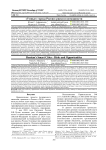
"Умные" города России: риски и возможности
Статья научная
За последние десять лет создание «умных городов» стало приоритетным направлением развития цифровой экономики в мире, в нашей стране создание подобных городов только начинает развиваться как в правовых и нормативных документах, так и в экономических, социальных направлениях. Достижение опорных точек пространственного развития экономики происходит за счет реализации проекта «Умный город». В нашей стране проект «Умный город» направлен на формирование эффективной системы управления городским хозяйством, создание безопасности и комфортных условий для жизни горожан и повышение конкурентоспособности российских городов. Реализация нацпроекта «Жилье и городская среда» и нацпрограммы «Цифровая экономика», реализуется в рамках нацпроекта «Умный город», который разработан Минстроем России и стартовал в 2018 г. Реализация проекта «Умный город» постепенно внедряются в различных субъектах Российской Федерации, используя цифровые технологии в развитии инфраструктуры городов. Внедрение данного проекта предполагает учет экономического потенциала региона, финансовые ресурсы, человеческий капитал (уровень образования и возраст населения), инновационный потенциал, который определяется наличием и качеством соответствующей бизнес инфраструктуры, научно-технической и образовательной базы. При внедрении каждого проекта не исключаются риски: социальные, экономические, политические, технологические, которые необходимо учитывать при реализации проекта «Умный город». В работе рассмотрены проблемы внедрение национального проекта в регионах, а также в ходе анализа выделены риски при создании «умных городов». Рассмотрены основные направления трендов развития «умных городов»: социальные, экономические, технологические. Проведен анализ IQ индекса крупнейших «умных городов» за период 2019-2020 годов. Выявлена динамика прироста «интеллектуального» индекса цифровизации городов России
Бесплатно
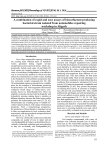
Статья научная
Routine washing, cleaning, repairing, maintenance of cars, bikes, scooters and disposal of waste of all kinds are carried out in automobile workshops are common observations in Aligarh. Considering the likelihood of existence of biosurfactant producing organisms at hydrocarbon contaminated site, a large number of soil samples were collected and isolation was carried out. A total of ten bacterial strains ALIG (01–10) were isolated out of which only isolate АLIG01 grown on GSP agar, Maconkey agar as well as on Pseudomonas agar plates which indicated suspected Pseudomonas spp. and exhibits positive biosurfactant activity through penetration assay, oil spreading technique, beta hemolytic activity and ЕI24 (96%), positive blue plate agar plate (> 2сm), qualatitative analysis, tolerance against hydrocarbon m-xylene, and microplate assay. This isolate АLIG01 is a valuable source to investigate further for future agriculture plant pathology and industrial applications.
Бесплатно
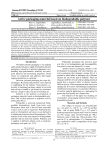
Active packaging material based on biodegradable polymer
Статья научная
Modern trends in processing, storage and packaging of food products are aimed at preserving the native properties of raw materials, ensuring hygienic safety, modern design and properties of the packaging material intended for the consumer. Pasteurized milk production includes following stages - normalization, heat treatment, packing and packaging, at which it is important to preserve the quality of the finished dairy product, that is why polymeric containers are used for most dairy products. The research was aimed to develop polymeric packaging for milk, characterized by additional material functions and capable of biological degradation after use. Polylactide with the introduction of an inert filler was chosen as a promising packaging material. The authors have produced electret films based on polylactide with the introduction of 2, 4 and 6% talc. Polarization of the samples was carried out by means of corona discharge on a unit with a square needle electrode with an area of 49 cm2. Increasing the talc content in the composition of samples contributed to the reduction of mechanical characteristics of materials. It was found that the introduction of talc into polylactide increases the electret properties of the material, which is based on the occurrence of additional traps of injected charge carriers. The developed polymeric material was tested using cow's milk industrially pasteurized at 74-76°C. Studies were conducted to evaluate the effect of electret polylactide film on acidity and microflora composition of pasteurized milk during storage at 37°C for 48 hours. In the presence of active packaging material, the formation of a dense milk clot and an increase in the acidity of the product were observed during the milk fermentation.
Бесплатно
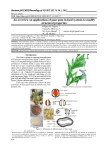
An overview on applications of guar gum in food systems to modify structural properties
Статья научная
Polysaccharides define as complex polymers composed of units interlinked with glycosidic bonds originated naturally. Polysaccharides are categorizing in several groups and among them, Gums are those with critical roles in food systems. Guar Gum is imparting softness, emulsification, stabilizing via its addition to formulas. This Gum is a fast soluble in cold water and can be active in a wide range of pH. The aim of this overview is giving an initial concept about guar gum and then convey to an introduction of its applications in food industries.
Бесплатно
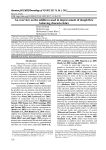
An overview on the additives used in improvement of dough flow behaving characteristics
Статья научная
Bread in all its diversity has cited as an ancient foodstuff for over 6000 years; bread dough, due to its viscoelastic behavior may consider as the most complicated rheological system which highly effects on final products’ sensorial and textural properties. Since the research dough rheology is of being challenging issues, therefore this explains why dough rheology has been an attractive title for several decades. Recently, demand to use new formula and sources such as cassava which result in enhancement of digestibility and along with it, the incorporation of aforesaid sources in cereal products, has been converted to a growingly investigation of rheological properties of dough. Substitution level of any novel sources directly effects on texture properties, even adverse affections, which evaluates by panelists therefore in this review we focus on different concepts of bread rheology and the affection of all added ingredients on physiochemical properties.
Бесплатно
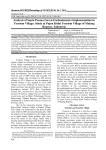
Статья научная
Tourism Village is the development of a region (village) by utilizing the elements that exist in the village community as a tourism product attribute that is able to provide and meet a series of needs of a tour. (Putra, 2006: 67). The existence of tourism villages in Indonesia is experiencing a very rapid development. The development was seen from the year of 2009 which only recorded 144 tourism villages that developed to 980 tourism villages in 2013. Moreover, the development of tourism villages is also targeted to reach 2000 villages next year. (Ministry of Tourism, 2014). Some provinces that develop tourism villages as destinations include: NTT, Bali, Yogyakarta, Central Java, and East Java. East Java itself has around 150 tourism villages that are scattered in several areas such as Blitar, Probolinggo, Pacitan, Banyuwangi, Malang Regency, and Batu City (Department of Culture and Tourism of East Java Province, 2014).
Бесплатно
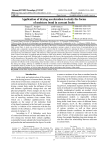
Application of drying acceleration to study the forms of moisture bond in currant fruits
Статья научная
The article discusses issues related to the study of the forms of connection of moisture removed during the drying process in black currant fruits. A study was carried out to determine the quantitative moisture content of various forms of communication by two methods and a comparative analysis was carried out. It is shown that the existing methods for studying the forms of moisture-material bonding have significant drawbacks and generally give a qualitative assessment of the state of moisture in the material or are very laborious and require long-term laboratory studies. The efficiency of the approach to determining the forms of moisture connection in black currant fruits is shown on the basis of graphical-analytical analysis of the drying kinetics, which allows qualitatively and quantitatively assessing the state of moisture in the fruits. With the help of a graphical editor, the curves of the drying kinetics of black currant fruits were processed and the dependences of the quantity called "drying acceleration" characterizing the rapidity of the change in the drying rate of currant fruits on the moisture content of the product were obtained. The analysis of the obtained curves is carried out, indicating the presence of extrema and points of inflection to the corresponding critical moisture content, as well as the presence of areas with a slowdown or acceleration of the drying rate change, allowing to establish the intervals of moisture removal with different binding energies. The approach under consideration makes it possible to give a quantitative and qualitative assessment of the physical state of moisture not only in currant fruits, but also in other food products, as well as reduce the time for analysis and improve the accuracy of the results.
Бесплатно
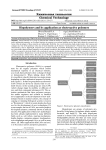
Biopolymers and its application as electroactive polymers
Статья научная
Smart materials are a group of materials that exhibit the ability to change their composition or structure, their electrical and/or mechanical properties, or even their functions in response to an external stimulus such as heat, light, electricity, pressure, etc. Some of the advantages of these materials are: lightweight, flexibility, low cost of production, high energy density, fast response and compact size. One of the promises in the area of smart materials can be found in “smart polymer”. Polymers have many attractive characteristics, such as: lightweight, inexpensiveness, fractures tolerant, and pliable. Furthermore, they can be configured into almost any conceivable shape and their properties can be tailored according to the required needs. The capability of electroactive polymers (EAPs) to respond to electrical stimuli with a mechanical response, is attracting the attention of the scientific community from a wide range of disciplines. Biopolymers in recent decades have been studied as potential electroactive materials. These groups of polymers are extracted from a natural source; thus, they are eco-friendly, additionally they stand as a cheaper solution for the development of smart materials.The present manuscript will explore some of its applications as EAPs.
Бесплатно
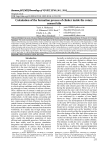
Calculation of the formation process of clinker inside the rotary cement kiln
Статья научная
This study examined the effect of the liquid phase on the heat required for clinker formation and the Coating index, and the relation of the Burning zone temp with the clinker and the heat required for clinker formation. The selection of the liquid phase at 1450 temperatures is beingmaterials difficulty in the Burning, and 1338 is being materials easy in the Burning. All tests and tests were conducted at the Nile Cement Company. The results proved that the more difficult the materials are, the more the Heat required for clinker formation and increase the cost of cement production, and the Coating thickness is weak but strong. The materials easy Burning being little the Heat required for clinker formation and Decreases the cost of cement production, and the Excessive but unstable coating with tendency to form thick ring formation. The found average difference in Heat required for clinker formation between temperature 1338 °C and 1450 °C is 82.26 kJ/kg-clinker representing 2.23% of Total heat input are 3686 kJ/kg-clinker.
Бесплатно
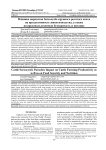
Статья научная
Cows and Bulls are mainly raised for milk and meat. Cattle Milk and meat play a vital role in the worldwide economies and contribute to food security and nutrition. For greater financial income accumulation, Cattle sourced Food products encompassing milk, butter, yogurt, ghee, cheese, Tenderized meat, meat sausage, etc. are sources of financial income for farmers and food producers. Unfortunately, Cattle Sarcocystosis disease can affect food security, and Cattle farmers’ economies by inducing reduced milk production, weight loss and decreased meat quality, abortion, and even death due to the effect these parasites have on Cattle (Hoeve-Bakker et al., 2019). Cattle Sarcocystosis disease is so far known to be specifically caused by six Sarcocystis spp infections in the Cattle. Each of the six (S.cruzi, S.hominis, S.heydorni, S.rommeli, S.hirsuta, & S.bovifelis) has its own different definitive host The two zoonoses (S. hominis & S. heydorni) share human as their common definitive host. Though the most prevalent among six bovine species, S. Cruzi, is not a zoonosis (Ayazian Mavi et al., 2020), it is a financial burden to the food producers and it may perpetuate malnutrition and Food insecurity. Therefore, Strengthened Control in Food Safety, Food biotechnology, and the Veterinary parasitological sector with the involvement of the public, civil society, and private sector are required to prevent the spread of sporocysts and protect water and Cattle Feed from Sarcocystis spp contamination.
Бесплатно
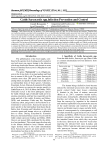
Cattle Sarcocystis spp. infection prevention and control
Статья научная
Cattle Sarcocystis spp. are protozoa. They often parasitise tissues of Cattle. Few of these species are zoonoses. Therefore, they are foodborne parasites associated with consumption of raw or insufficiently thermally treated sarcocystic beef meat. Swallowing oocysts from environmental objects primarily contaminated water, garden crops, grazing on contamited pasture, etc. can cause Cattle sarcocystosis. Sarcocystis spp specific to Cattle include S.hominis, S.heydorni, S.cruzi, S.hirsuta, S.rommeli &S.bovifelis. Among them, S.hominis and S.heydorni are zoonotic and pathogenic agents. Human Intestinal/ Muscular Sarcocystosis is a disease that caused by eating raw or poorly cooked Cattle meat infected by Sarcocystis zoonoses (S.hominis&S.heydorni). Intestinal Sarcocystosis was reported almost from all corners of the world. This has been well documented but no powerful Preventive and control methods available to public yet. With the world growing population, researchers should provide or suggest practical solution to supply safe food to the consumers. During our research work we tried to compare the effectiveness of all available documented Cattle sarcocystis spp. Testing methods to recommend the best one to the public for screening health from infected Cattle before slaughter in the slaughter house. Though culture and society play a fundamental role in foodborne control, we also came up with additional control safety measures recommendations all along the beef meat supply chain.
Бесплатно

Статья научная
Results of international comparative interlaboratory tests on defining contents of nitrogen oxides (NO, NOx) in gaseous phase of aerosol of heated tobacco products are presented in the article. The objects of study were samples of heated tobacco intended for use with electric tobacco heating systems of the IQOS, Glo and Ploom brands. The determination of nitrogen oxides in the gas phase of aerosol from heated tobacco products was carried out using a technique developed in the laboratory of chemistry and quality control of the Federal State Budget Scientific Research Institute “All Russian research institute of tobacco, makhorka and tobacco products”. The aim of interlaboratory comparative tests is calculation of intra- and interlaboratory variability (repeatability and reproducibility). Mandel h and k statistics were utilized for statistical compatibility analysis. Analysis of interlaboratory compatibility was carried by z - index, statistical identifying of outliers was carried by Cochran’s and Grubbs’ criteria. Also, repeatability and reproducibility were calculated. Statistical analysis of interlaboratory comparative tests results proved high level of validity of obtained data. Establishing metrological characteristics is a key aspect of ensuring the reliability and applicability of the methodology. Interlaboratory comparative tests for nitrogen oxides defining are the first time carried in Russia and are actual for innovative products from heated tobacco.
Бесплатно
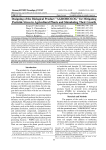
Статья научная
The results of the selection of new plant growth-promoting bacteria resistant to herbicides of different chemical structure are presented. Two methods were used for screening: sowing on microbiological media from freshly sampled soil and obtaining enrichment cultures from soil samples exposed to herbicides for a month at a temperature of 28 °C. Inoculation was carried out on selective nutrient media containing herbicides Octapon extra (2,5 g/l), Florax (2,5 g/l), Dicamba (1 g/l), Nanomet (1 g/l), Spetsnaz (1 g/l) or Chistalan (2,5 g/l). These herbicides are commonly used to control weeds in wheat crops. The isolated microorganisms belong to the genus Pseudomonas, fix nitrogen, mobilize phosphates, synthesize phytohormones and antimicrobial compounds. They also can mitigate pesticide stress of crops. An anti-stress biological product containing them has been developed and tentatively named "AGROBIOLOG". For its production, the optimal composition of the nutrient medium and the conditions for industrial submerged cultivation on reactors of various volumes were determined. In the laboratory fermenter FA10 with a volume of 10 liters after 72 hours of cultivation at a temperature of 28 °C, a stirrer speed of 200 rpm, aeration of 0.5 volumes of air per 1 min per 1 volume of medium, the amount of viable cells was 28 billion CFU/ml of culture liquid. Cultivation on biological reactors with a volume of 1000 liters under the same conditions allowed to achieve a titer of 6.0 billion CFU/ml of culture liquid.
Бесплатно
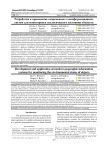
Краткое сообщение
The article presents the results of the application of geographic information systems for environmental auditing, which allows you to monitor the ecological situation on the objects, food and chemical industries and to ensure environmental safety of natural and industrial areas. The authors propose a mathematical model that performs monitoring of environmental objects. The computational experiment is performed in Matlab for classifying the soil measurement conditions. The results of the analysis and the electronic cartograms constructed on their basis are used to predict the location of the points exceeding the parasitological indices in the soil. The assessment of the condition of the soil in different districts of the Voronezh city is made with the help of the created neural networks. The results are compared with the same indicators, measured in 2017. Data is taken from the information Bulletin «Evaluation of the influence of environmental factors on the health of the population of the Voronezh region on indicators of socio-hygienic monitoring»...
Бесплатно
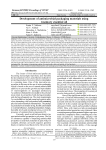
Development of antimicrobial packaging materials using rosemary essential oil
Статья научная
In the context of increasing requirements for food safety and quality, it is important to develop effective methods of protection against microbial contamination. One of the innovative solutions is active packaging with natural antimicrobial additives that prevent the growth of microorganisms on the surface of products. These additives must retain their properties both during production and during further use. The main objective of this study was development of an active packaging film made of biopolymer with the introduction of rosemary essential oil in various concentrations, as well as determination of the antimicrobial, physical, mechanical and barrier properties of the resulting polymer material. The starch-based film was prepared by mechanical mixing of the initial reagents with the introduction of rosemary essential oil with a concentration of 0.5%; 1%; 3%; 5%. The antimicrobial properties of the polymer packaging material were determined by the disk-diffusion method in accordance with MUK 4.2.1890–04 in relation to Bacillus subtilis, Escherichia coli, Candida albicans, and Aspergillus niger. To assess the fungal resistance of the materials, the methods of GOST 9.049 (method 1) and GOST 9.048 (method 4) were selected. Determination of vapor permeability using the "PERME W3/030" device according to GOST GВ1037. The method for determining the physical and mechanical properties on a tensile testing machine according to GOST 28840–90. It was found that samples of packaging film based on starch with rosemary essential oil have antimicrobial activity against Candida albicans at concentrations of 3% and 5%, reducing the number of microorganisms on the film surface. In addition, its physical, mechanical and barrier properties are improved. Analysis of existing studies has shown that rosemary essential oil is an effective natural antimicrobial component. Its use in active starch-based packaging not only prevents the growth of microorganisms such as Candida albicans, but also helps improve the physical, mechanical and barrier properties of the packaging film. This makes it a promising solution for ensuring the safety and quality of food products.
Бесплатно
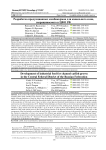
Статья научная
In the result of the analysis of domestic experience over the last 10 years of foreign experience (for example, 9 countries: Vietnam, India, Spain, Canada, China, Norway, USA, Chile, Japan, which possess the most advanced technologies and equipment for highly efficient production of feed for fish) in the development of innovative technologies and equipment for production of high-performance fish feeds were identified that the methods both dry and wet pressing are outdated and do not meet modern requirements in the production of fish feeds since it does not allow a deep physical-chemical transformations in protein-carbohydrate complex and exercise enter fat components at 40 %. Modern fish technologies are based on the use of extrusion processing of multicomponent mixture to give different buoyancy and adjustable rate of immersion of the resulting feed. Extrusion technology will allow to introduce a large amount of fat into the product - up to 35-40 %, to achieve 100 % starch splitting level. Based on the study of the nutrition of the canal catfish grown in the Central Federal District of the Russian Federation, the nutritional value of each of the components of the feed mixture, providing the need for fish to ensure a significant increase in the growth of live mass and improve the chemical composition of meat, was assessed for different age groups. To solve this problem, the "Feed Optima Expert" optimization program has developed products of extruded feed. Food needs of canal som: 30 - 40 percent protein, 4 - 6 percent fat, no more than 5 percent fiber, 35 - 40 percent Nosazotic Extract substances and 12 - 13 thousand kilos of Joule digestible energy in 1 kilogram (in recalculation on dry matter).
Бесплатно
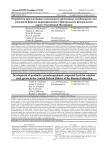
Статья научная
The decrease in catch of valuable fish species from natural water bodies is compensated by their intensive cultivation in artificial conditions. In order to realize the main task of trout farms associated with obtaining marketable products in the shortest possible period of time, artificial feed is used as a source of food. A economically feasible alternative source of raw materials is the products of plant origin. In the process of production of oil and fat products at various stages, numerous fat wastes and by-products are formed, wich have fodder value and are not used as feeding facilities in industrial scale. This is especially frue for fat processing (soapstock of Light oil, fatty bleaching clays, dezodoration chases, phosphatides, calcium salts of fatty acids), as well as waste oils in combination with fat processing waste. On the base of studying the classical technology of producing mixed fodders for valuable fish species and eliminating its drawbacks the technology of pseudocapsulated mixed fodders for salmon fish grown in the CFD of Russia Federation with given fodder value and a line for its realization is suggested. The best way to bring fats and vitamins contained in them to valuable fish species is to feed them as a part of mixed fodders. At present, however, it is difficult to increase the level of fat in feed on the existing Russian fats supply lines, since most plants can include up to 10% of fat in the bulk feed line. Therefore, the development of mixing formulations and techniques for valuable fish breeds using sturgeon fish with more than 10% fat in it as an addition of fat oily wastes such as epaulettes and phosphates is not only of scientific interest. In the course of studies optimization encapsulated optimal feeds for program "Feed Optima Expert" pseudorainbow trout were also developed. As a result, close results were obtained in terms of the rate of growth of trout, the development, conversion of feed and viability in comparison with the best feed counterparts on the Russian market.
Бесплатно
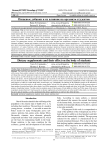
Dietary supplements and their effect on the body of students
Статья научная
The world does not stand still. We are daily confronted with the achievements of modern science: we are able to communicate with a person from another continent via the Internet, we easily bypass any distance thanks to different modes of transport. And yet there are things that cannot be automated, improved, accelerated yet. A person still needs to sleep, have some physical activity during the day and, of course, eat. The whole day of a person can easily obey the rhythm: breakfast, lunch, dinner, and, of course, snacks, afternoon tea, brunch, late dinner. And it's getting harder and harder to give up food, as store shelves are bursting with goods that are ready to lie there for years until we buy them. This is because most of the foods we consume contain various dietary supplements in their composition. The main purpose of which is to make them tastier, stored longer, etc. Undoubtedly, the nutrition of all population groups can be affected by food additives, but in this article we will consider young people: 2nd and 3rd year students. Of course, studying, writing course projects, a large number of practical and other classes deprive you of the opportunity, or rather the strength and desire, to eat right. Therefore, this age group is of particular interest. To what extent are students aware of the presence of food additives in their food? How many of the survey respondents monitor their diet? And in general: are dietary supplements as harmful as they say in the media? In this article, we will analyze the survey data of students, as well as understand what dietary supplements are and how they affect the body.
Бесплатно

Статья научная
Protein deficiency in the diets of various determined groups of consumers is a serious nutritional problem. The problem of protein deficiency in diets can be solved by developing protein mixtures for their enrichment, taking into account trends in personalized nutrition. Whey processing using membrane technologies corresponds to the concept of Green, Circular, Bio economy. Membrane technologies make it possible to fractionate various whey components and obtain high-tech protein products. The aim of the study is to develop a basic recipe, assess the organoleptic properties and physicochemical characteristics of a dry protein mixture based on whey proteins obtained on the basis of membrane methods. Whey protein concentrate UF WPC - 80 was used as the main component of the protein mixture. Whey protein concentrate and isolate in a 6:1 ratio form the basis of the protein mixture we have developed. We offered options for expanding the range of flavoring additives for dry protein mixtures by combining traditional flavoring additives "Strawberry", "Cherry", "Apple", "Pineapple", "Melon". We have provided an optional addition of papaya and pineapple extracts in case of decreased activity of digestive enzymes, for example, in the elderly people. The technological scheme for obtaining the finished product provides for two-stages dry mixing of the components and the use of commercially available equipment. The protein mixture is a dry powder and is recommended for use in liquid form by restoring it with water, milk or natural juice, for example, veatgrass. We investigated the composition and properties of the developed dry protein mixture in accordance with official and generally recognized test methods. The developed product meets the requirements of TR CU 021/2012 "On food safety" and can be recommended to increase the adaptive capabilities of consumers of various age and physiological groups to physical and neuro-emotional stress, as a fortifying component of diets
Бесплатно

